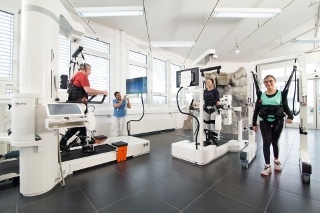May 23 2016
For patients and therapists, believing in the benefits state-of-the-art robotic medical devices bring to the table is one thing. But having your beliefs incorporated into the official practice guidelines by associations of experts and authorities in the field is something entirely different.
 Hocoma Robotic Devices (Photo: Business Wire)
Hocoma Robotic Devices (Photo: Business Wire)
Yet this is exactly what is happening. The newest Guidelines for Adult Stroke Rehabilitation and Recovery from the American Heart Association/American Stroke Association (AHA/ASA) were recently published. The following statements can be found in this important publication1:
Robot-assisted movement training, to improve motor function and mobility after stroke in combination with conventional therapy, is beneficial for patients.
Robot-assisted gait training is specifically beneficial for patients who are non-ambulatory or have low ambulatory ability early after stroke.
Combining robot-assisted gait training with virtual reality can further be beneficial for the improvement of gait.
Scientific studies back the statements the AHA/ASA are putting forth. The end goal is to provide a synopsis of best clinical practices in the rehabilitative care of adults recovering from stroke; and Hocoma fully agrees with these statements and recommendations.
Hocoma, the world leader in developing advanced medical solutions and inventor of the most-trusted robotic gait trainer, firmly believes their Lokomat helps. On one hand, patients can train more accurately and more intensively, and on the other, therapists can simplify their workflow and assessment of patient progress. And the fact that these beliefs are not only being embraced by the institutions in the field, but are also supported by more than 250 published scientific papers, is an important step forward for rehabilitation therapy.
1 References:
"Guidelines for Adult Stroke Rehabilitation and Recovery"
http://stroke.ahajournals.org/content/early/2016/05/04/STR.0000000000000098.full.pdf+html?sid=7f40d463-5fde-43bd-aa07-ea26dc5a2fb1
"First-Ever AHA/ASA Stroke Rehab Guidelines Support IRFs, Interprofessional Approaches"
http://www.apta.org/PTinMotion/News/2016/5/10/StrokeRehabPracticeGuidelines/
Source: https://www.hocoma.com/